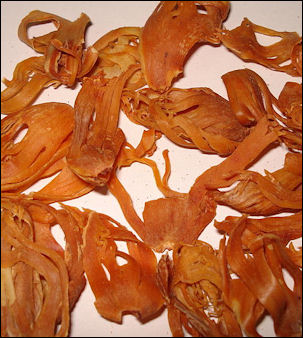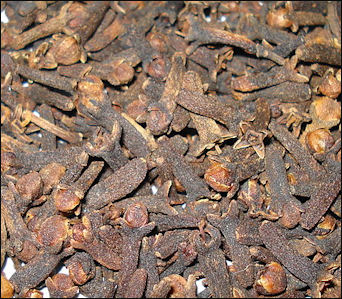NUTMEG
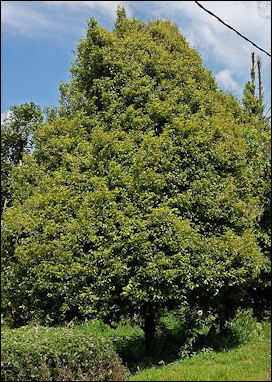
Nutmeg tree
Nutmeg is the bright red and black kernel (seed) of a yellow, edible, apricot-like fruit from the nutmeg tree, a large evergreen, native to the Moluccas (the Spice Islands in Indonesia). The "filmy" red membrane of fruit that coats the nut is the source of mace, another spice which has a flavor quite different from nutmeg. The nutmeg kernel is an unreal-looking red color that looks hand painted.
Nutmeg itself is poisonous. Only a small amount of it should be eaten. The flavor and fragrance comes from myristica, a mild, poisonous narcotic. Other chemicals are similar to those found in the rave drug ecstacy. Nutmeg has historically been a hypnotic agent. Some people take it to get high. Large amounts can induce hallucinations, epileptic-style seizures and even death.
Some 80 percent of the word's nutmeg still comes from Indonesia. Much of the rest comes from Grenada Nutmeg grown on plantations in the Moluccas (East Indian nutmeg) is exported mostly to Asia and Europe. Nutmeg produces in Grenada (West Indian nutmeg) is exported mostly to the United States. Wild nutmeg trees still grow in the forest of Butu and other islands in the Spice Islands.
The use of nutmeg goes back thousands of years. According to Archaeology magazine: The oldest evidence — from some 3,500 years ago — for humans ingesting nutmeg has been detected on pottery sherds from Pulau Ay in the Banda Islands. Researchers do not know whether it was being used for its fruit, as a spice to flavor food, or for medicinal purposes. But Neolithic Indonesian communities were clearly familiar with its unique properties and flavor long before it became a sought-after global commodity. [Source: Archaeology magazine, January-February 2019]
RELATED ARTICLES:
SPICES, TRADE AND THE SPICE ISLANDS factsanddetails.com
INDONESIA WHEN EUROPEANS FIRST ARRIVED: SPICES, POWERFUL STATES, DEALS, ISLAM factsanddetails.com
EARLY INDIANS, CHINESE AND ARABS IN INDONESIA: IBN BATTUTA, YIJING, ZHENG HE factsanddetails.com
EARLY EUROPEAN EXPLORERS IN INDONESIA: MARCO POLO, NICOLÒ DEI CONTI, MAGELLAN'S CREW factsanddetails.com
AGE OF EUROPEAN EXPLORATION factsanddetails.com
PORTUGUESE IN INDONESIA factsanddetails.com
PORTUGAL AND THE AGE OF DISCOVERY factsanddetails.com
PORTUGUESE TRADE EMPIRE IN ASIA factsanddetails.com
EARLY DUTCH PERIOD IN INDONESIA AND THE DUTCH EAST INDIA COMPANY (VOC) factsanddetails.com
DUTCH EMPIRE: WEALTH, EXPLORATION AND HOW IT WAS CREATED factsanddetails.com
DUTCH, THE SPICE TRADE AND THE WEALTH GENERATED FROM IT factsanddetails.com
Uses of Nutmeg
In the West, nutmeg it is grated and used as a flavoring in sweet, spicy dishes, fruit cakes, seafood sauces and liqueurs and is key ingredient for mulled wines and Christmas eggnog. In the Middle East, Iran and northern India it is used in delicately flavored meat dishes. The Chinese use it to preserve sausage. The Japanese put it in fish curry. The Dutch sprinkle it on mashed potatoes. Germans add it to sauerkraut.
Nutmeg is believed to be the secret ingredient in Coca Cola, which is said to be the world’s largest consumer of nutmeg. Nutmeg favored cordials consumed in Indonesia taste like Coca Cola without the fizz. Nutmeg fruit is consumed in the Moluccas despite its chemically smell.
Various medicinal and magical powers have been ascribed to nutmeg. The spice has traditionally been worn as an amulet to ward off evil spirits, broken bones and boils. Tucking in one’s armpit is said to help one make friends. A 16th century monk advised young men to rub it on their genitals to give them long-lasting potency. In some places it is used as a treatment for vomiting, diarrhea and loss of appetite. The price in the early 2000s was around $8 and $10 a pound. Increasing demand from Eastern Europe has raised the price.
Nutmeg Tree
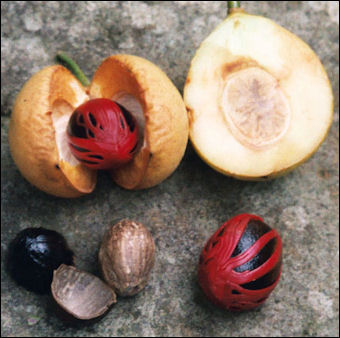
nutmeg parts
here are around 80 different species of nutmeg. The most common type is an evergreen that reaches a height of 40 feet and has small yellow flowers; silver-lined, dark-green, 5-inch leaves; short bushy branches that extend out from the base to the tip; and dark grey-green bark that produces a yellow juice that turns red when it oxidizes.
The fruit has a downy texture like a peach and flesh that is yellow with a slight orangish color. When the fruit is ripe it spits open, revealing the bright red casing of mace. The nutmeg itself is a kernel about he size of plum. In the old days people used to keep the kernel in their pockets with a grater which they used to shave off pieces that were added to meat or ale.
The seeds of wild nutmeg trees are dispersed with the help of a species of green pigeon that needs the seed to properly digest its food. The pigeon has the ability to unhitch its lower beak and expand its mouth to accommodate the huge nutmeg kernel which is often larger than the pigeon’s head.. Most seeds are regurgitated. Smaller ones pass through its digestive system and are expelled with fertilizer that helps it grows.
Nutmeg trees bloom and bear fruit the entire year. They bear fruit for 50 or so years, reaching their peak when they are 15 years old and producing steadily less and less after that until production dwindles to nothing. The fruit are ready to harvest when they are yellow in color and the air is filled with a sweet smell. A single tree can produce up to 2,000 nutmegs a year.
Nutmeg Cultivation and Processing
Nutmeg trees grows best in volcanic soils in slightly elevated areas near the sea in hot, humid tropical climates. They need shade trees to protect them form the hot tropical sun and grow best in dense tropical rain forests. Saplings are produced from seeds sprouted in nursery beds and transplanted to plantations. The trees take about five years to flower. Female trees are desired because they produce more fruit. When they mature the male plants are thinned out so that the nutmeg-bearing females predominate at a ratio of 10 to 1.
In the Moluccas nutmeg is picked with a pole with a knife at one end or a long lacrosse-stick-like pole with a strange "lozenge shaped woven rattan basket with a non-return valve and two fangs for hooking fruit." The fruit is collected in a rattan baskets that looks like a basketful of red muscle shells when full. On Banda island, nutmeg is picked by workers who are allowed to keep half of what they pick.
mace After the fruit is harvested the sour, tough, almost woody outer pulp is removed. In Indonesia it is regarded as a delicacy and preserved in syrup. Under the husk is a lacy scarlet fiber covering (the aril). Under the mace is the nut-like pit. Inside this is the inch-long ridged nutmeg seed. The seeds are slightly wrinkled and dark brown on the outside and light brown on the inside.
Workers cut the fruit with a paring knife and leave it under the tree so the mace and nutmeg dry in the sun. The mace is striped from the nuts and is dried and flattened between boards. The nuts are dried until they rattle and then they are shelled. At the mill, the mace is ground into a powder while the nuts are usually shipped whole to preserve their flavor. Nutmeg powder loses its flavor quickly. Low quality nuts are ground and used to make "oil of mace" or nutmeg butter.
World’s Top Nutmeg, Mace and Cardamom Producing Countries
World’s Top Producers of Nutmeg, Mace and Cardamoms (2020): 1) Indonesia: 42338 tonnes; 2) India: 41000 tonnes; 3) Guatemala: 38610 tonnes; 4) Nepal: 9545 tonnes; 5) Sri Lanka: 4120 tonnes; 6) Laos: 3053 tonnes; 7) Bhutan: 2175 tonnes; 8) Tanzania: 721 tonnes; 9) Grenada: 656 tonnes; 10) Honduras: 574 tonnes; 11) Trinidad and Tobago: 329 tonnes; 12) Saint Vincent and the Grenadines: 156 tonnes; 13) Ethiopia: 154 tonnes; 14) Papua New Guinea: 110 tonnes; 15) Malawi: 93 tonnes; 16) Kenya: 58 tonnes; 17) Malaysia: 43 tonnes; 18) Saint Lucia: 34 tonnes; 19) Togo: 33 tonnes; 20) Madagascar: 16 tonnes. [Source: FAOSTAT, Food and Agriculture Organization (U.N.), fao.org. A tonne (or metric ton) is a metric unit of mass equivalent to 1,000 kilograms (kgs) or 2,204.6 pounds (lbs). A ton is an imperial unit of mass equivalent to 1,016.047 kg or 2,240 lbs.]
World’s Top Producers (in terms of value) of Nutmeg, Mace and Cardamoms (2019): 1) Indonesia: Int.$171912,000 ; 2) Guatemala: Int.$150084,000 ; 3) India: Int.$148571,000 ; 4) Nepal: Int.$31098,000 ; 5) Sri Lanka: Int.$15174,000 ; 6) Laos: Int.$11894,000 ; 7) Grenada: Int.$10447,000 ; 8) Bhutan: Int.$5524,000 ; 9) Tanzania: Int.$2866,000 ; 10) Honduras: Int.$2103,000 ; 11) Trinidad and Tobago: Int.$1435,000 ; 12) Saint Vincent and the Grenadines: Int.$860,000 ; 13) Ethiopia: Int.$657,000 ; 14) Papua New Guinea: Int.$391,000 ; 15) Malawi: Int.$242,000 ; 16) Kenya: Int.$238,000 ; 17) Saint Lucia: Int.$137,000 ; 18) Togo: Int.$133,000 ; 19) Malaysia: Int.$133,000 ; [An international dollar (Int.$) buys a comparable amount of goods in the cited country that a U.S. dollar would buy in the United States.]
Top Producing Countries in 2008 (Production, $1000; Production, metric tons , FAO): 1) Guatemala, 40180 , 28000; 2) India, 22171 , 15450; 3) Indonesia, 12341 , 8600; 4) Nepal, 11688 , 8145; 5) Bhutan, 8323 , 5800; 6) Grenada, 4018 , 2800; 7) Lao People's Democratic Republic, 3874 , 2700; 8) United Republic of Tanzania, 1004 , 700; 9) Malaysia, 861 , 600; 10) Sri Lanka, 574 , 400; 11) Honduras, 502 , 350; 12) Saint Vincent and the Grenadines, 229 , 160; 13) Trinidad and Tobago, 222 , 155; 14) Ethiopia, 143 , 100; 15) Kenya, 71 , 50; 15) Malawi, 71 , 50; 17) Saint Lucia, 43 , 30; 17) Togo, 43 , 30; 19) Madagascar, 14 , 10; 20) Dominica, 7 , 5;
World’s Top Nutmeg, Mace and Cardamom Exporting and Importing Countries
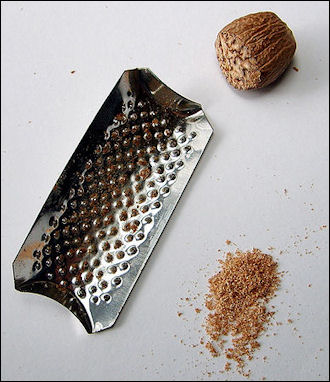
nutmeg World’s Top Exporters of Nutmeg, Mace and Cardamoms (2020): 1) Guatemala: 65283 tonnes; 2) Indonesia: 28950 tonnes; 3) India: 9895 tonnes; 4) United Arab Emirates: 8944 tonnes; 5) Nepal: 7150 tonnes; 6) Myanmar: 4399 tonnes; 7) Netherlands: 2918 tonnes; 8) Sri Lanka: 2216 tonnes; 9) Singapore: 1289 tonnes; 10) Honduras: 995 tonnes; 11) Germany: 965 tonnes; 12) Vietnam: 785 tonnes; 13) Saudi Arabia: 763 tonnes; 14) Grenada: 733 tonnes; 15) United States: 728 tonnes; 16) United Kingdom: 557 tonnes; 17) Bhutan: 390 tonnes; 18) Turkey: 386 tonnes; 19) Belgium: 385 tonnes; 20) Italy: 377 tonnes. [Source: FAOSTAT, Food and Agriculture Organization (U.N.), fao.org]
World’s Top Exporters (in value terms) of Nutmeg, Mace and Cardamoms (2020): 1) Guatemala: US$1136599,000; 2) Indonesia: US$222895,000; 3) United Arab Emirates: US$150719,000; 4) India: US$148923,000; 5) Netherlands: US$45175,000; 6) Nepal: US$43220,000; 7) Singapore: US$24238,000; 8) Vietnam: US$21230,000; 9) Saudi Arabia: US$18822,000; 10) Germany: US$18169,000; 11) Sri Lanka: US$17585,000; 12) Myanmar: US$11207,000; 13) United Kingdom: US$10289,000; 14) Honduras: US$5330,000; 15) United States: US$4642,000; 16) Grenada: US$4516,000; 17) Belgium: US$4258,000; 18) France: US$4060,000; 19) Spain: US$3922,000; 20) Italy: US$3718,000
World’s Top Importers of Nutmeg, Mace and Cardamoms (2020): 1) Saudi Arabia: 10929 tonnes; 2) India: 10245 tonnes; 3) China: 9999 tonnes; 4) Bangladesh: 9762 tonnes; 5) United Arab Emirates: 9608 tonnes; 6) United States: 4511 tonnes; 7) Netherlands: 3722 tonnes; 8) Pakistan: 3627 tonnes; 9) Germany: 3012 tonnes; 10) Egypt: 2405 tonnes; 11) United Kingdom: 2000 tonnes; 12) Jordan: 1653 tonnes; 13) Spain: 1640 tonnes; 14) Kuwait: 1611 tonnes; 15) Singapore: 1399 tonnes; 16) Iraq: 1341 tonnes; 17) Oman: 1270 tonnes; 18) Yemen: 1175 tonnes; 19) Canada: 1169 tonnes; 20) Japan: 962 tonnes. [Source: FAOSTAT, Food and Agriculture Organization (U.N.), fao.org]
World’s Top Importers (in value terms) of Nutmeg, Mace and Cardamoms (2020): 1) Saudi Arabia: US$307538,000; 2) United Arab Emirates: US$172140,000; 3) Bangladesh: US$150264,000; 4) India: US$91410,000; 5) China: US$84592,000; 6) United States: US$55331,000; 7) Netherlands: US$51597,000; 8) Kuwait: US$43302,000; 9) Germany: US$43090,000; 10) Egypt: US$42735,000; 11) Oman: US$32455,000; 12) United Kingdom: US$32305,000; 13) Jordan: US$30743,000; 14) Singapore: US$25643,000; 15) Yemen: US$22337,000; 16) Iraq: US$21586,000; 17) Qatar: US$20156,000; 18) Japan: US$19475,000; 19) Pakistan: US$17558,000; 20) Vietnam: US$15755,000 [Source: FAOSTAT, Food and Agriculture Organization (U.N.), fao.org]
Cloves
Cloves are the dried, unopened flower buds of the “cenkeh" , or clove tree, an evergreen tree related to myrtle. Grown primarily in Indonesia, Zanzibar and the West Indies, cloves are about a half inch long with a knob at one end with unopened pedals. The word "cloves" is derived from the French word for nail, “chou” , a reference to the cloves shape.
cloves Strongly aromatic and sweetly pungent, cloves are used as a flavoring and scent for mulled wines, chewing gum, perfumes, toothpaste and Indonesian cigarettes. The oil of cloves, derived by distillation with water, has antiseptic properties and is an ingredient in soaps, ointments and drugs. Synthetic vanilla is made from eugenol an ingredient of clove oil. Cloves are a key ingredient in Worcestershire sauce. In the past they were prescribed as cure for toothache, bad breath and a low sex drive.
Cloves originated from Ternate, Tidore and Bacan, Indonesian islands in the Moluccas. They were mentioned by the Chinese in 400 B.C. During the Han dynasty Chinese were permitted to address their emperor only once their breath has been sweetened with “odoriferous pistols” — a reference to cloves.
Cloves were delivered to the Romans by Arab traders and prized as a medicament in medieval times. The Dutch cultivated cloves trees on the Molucca Island of Ambon and had a monopoly on the trade until the French introduced them to Zanzibar and the neighboring Pemba.
Clove Agriculture and Processing
Cloves grow best is cool, moist air like that found in the hills not far from the sea in southern Java, Sulawesi. Seram and Ambon in the Moluccas in Indonesia. Clove trees reach heights of up to 45 feet. The leaves are shiny, dark green and very fragrant. Small red flowers grow in clusters of three at the end of the branches.
Cloves need rain fall of at least 60 inches and a dry season for harvesting and curing. The bulbs are first pale in color, and then turn green. They are harvested by hand when they are bright red, before the buds open. They are dried on palm mats and are dark brown when they dry.
Indonesia is the world's largest producers of cloves. Nearly all the cloves produced there are purchased domestically to produce “kreteks” (clove cigarettes). They are also cultivated in Brazil, the West Indies, Mauritius, Madagascar, India, Sri Lanka, Zanzibar and Pemba in Tanzania and Malaysia.
Before 1990, most farmers in Indonesia sold their cloves to local cooperatives that helped dry and store the cloves and sold them to mostly to cigarette makers. Clove farmers did so well they bought refrigerators and televisions as status symbols even though hey had no electricity.
World’s Top Clove Producing Countries

clove flowers in a tree World’s Top Producers of Cloves (2020): 1) Indonesia: 133604 tonnes; 2) Madagascar: 23931 tonnes; 3) Tanzania: 8602 tonnes; 4) Comoros: 6799 tonnes; 5) Sri Lanka: 6711 tonnes; 6) Kenya: 2057 tonnes; 7) China: 1294 tonnes; 8) Malaysia: 220 tonnes; 9) Grenada: 40 tonnes
[Source: FAOSTAT, Food and Agriculture Organization (U.N.), fao.org. A tonne (or metric ton) is a metric unit of mass equivalent to 1,000 kilograms (kgs) or 2,204.6 pounds (lbs). A ton is an imperial unit of mass equivalent to 1,016.047 kg or 2,240 lbs.]
World’s Top Producers (in terms of value) of Cloves (2019): 1) Indonesia: Int.$146176,000 ; 2) Madagascar: Int.$25073,000 ; 3) Tanzania: Int.$9728,000 ; 4) Comoros: Int.$7018,000 ; 5) Sri Lanka: Int.$4747,000 ; 6) Kenya: Int.$2589,000 ; 7) China: Int.$1521,000 ; 8) Malaysia: Int.$247,000 ; [An international dollar (Int.$) buys a comparable amount of goods in the cited country that a U.S. dollar would buy in the United States.]
Top Clove Producing Countries in 2008 (first Production, $1000; second Production, metric tons FAO): 1) Indonesia, 127687 , 80929; 2) Madagascar, 15777 , 10000; 3) United Republic of Tanzania, 15619 , 9900; 4) Sri Lanka, 6295 , 3990; 5) Comoros, 5522 , 3500; 6) Kenya, 1577 , 1000; 7) China, 1301 , 825; 8) Malaysia, 315 , 200; 9) Grenada, 31 , 20;
World’s Top Clove Exporting Countries
World’s Top Exporters of Cloves (2020): 1) Indonesia: 47765 tonnes; 2) Madagascar: 14752 tonnes; 3) Tanzania: 5319 tonnes; 4) United Arab Emirates: 4846 tonnes; 5) Singapore: 4563 tonnes; 6) Brazil: 4139 tonnes; 7) Sri Lanka: 2845 tonnes; 8) Comoros: 1975 tonnes; 9) India: 949 tonnes; 10) Egypt: 826 tonnes; 11) Germany: 537 tonnes; 12) Netherlands: 496 tonnes; 13) China: 388 tonnes; 14) Spain: 209 tonnes; 15) Vietnam: 209 tonnes; 16) United States: 191 tonnes; 17) France: 187 tonnes; 18) Hong Kong: 187 tonnes; 19) United Kingdom: 169 tonnes; 20) Dominican Republic: 153 tonnes. [Source: FAOSTAT, Food and Agriculture Organization (U.N.), fao.org]
World’s Top Exporters (in value terms) of Cloves (2020): 1) Indonesia: US$176541,000; 2) Madagascar: US$63706,000; 3) Tanzania: US$31549,000; 4) Singapore: US$25506,000; 5) Brazil: US$18934,000; 6) United Arab Emirates: US$18466,000; 7) Sri Lanka: US$16959,000; 8) Comoros: US$8243,000; 9) India: US$6554,000; 10) Germany: US$5363,000; 11) Netherlands: US$3972,000; 12) France: US$1903,000; 13) Spain: US$1860,000; 14) United Kingdom: US$1573,000; 15) China: US$1387,000; 16) Vietnam: US$1309,000; 17) Austria: US$947,000; 18) United States: US$857,000; 19) Turkey: US$665,000; 20) Poland: US$626,000
World’s Top Clove Importing Countries
World’s Top Importers of Cloves (2020): 1) India: 30621 tonnes; 2) United Arab Emirates: 5000 tonnes; 3) Singapore: 3412 tonnes; 4) China: 2709 tonnes; 5) Indonesia: 2575 tonnes; 6) United States: 2368 tonnes; 7) Saudi Arabia: 2287 tonnes; 8) Pakistan: 2137 tonnes; 9) Malaysia: 2040 tonnes; 10) Bangladesh: 1771 tonnes; 11) Algeria: 1519 tonnes; 12) Iraq: 1284 tonnes; 13) Egypt: 1244 tonnes; 14) Germany: 1157 tonnes; 15) Yemen: 1087 tonnes; 16) Peru: 1061 tonnes; 17) Nigeria: 833 tonnes; 18) Ghana: 816 tonnes; 19) Turkey: 723 tonnes; 20) Netherlands: 684 tonnes. [Source: FAOSTAT, Food and Agriculture Organization (U.N.), fao.org]
World’s Top Importers (in value terms) of Cloves (2020): 1) India: US$170706,000; 2) United Arab Emirates: US$19790,000; 3) Singapore: US$18300,000; 4) United States: US$15263,000; 5) Malaysia: US$13103,000; 6) Indonesia: US$12343,000; 7) Saudi Arabia: US$11790,000; 8) China: US$11084,000; 9) Bangladesh: US$10354,000; 10) Pakistan: US$9912,000; 11) Germany: US$6695,000; 12) Peru: US$5577,000; 13) Egypt: US$4637,000; 14) Yemen: US$4616,000; 15) Netherlands: US$4550,000; 16) Iraq: US$4137,000; 17) Nigeria: US$4036,000; 18) France: US$3743,000; 19) Ghana: US$3652,000; 20) United Kingdom: US$3384,000
Image Sources: Wikimedia Commons
Text Sources: National Geographic, New York Times, Washington Post, Los Angeles Times, Smithsonian magazine, Natural History magazine, Discover magazine, Times of London, The New Yorker, Time, Newsweek, Reuters, AP, AFP, Lonely Planet Guides, Compton’s Encyclopedia and various books and other publications.
Last updated December 2025

